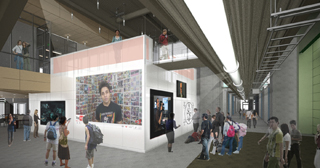|
Subscribe / Renew |
|
|
Contact Us |
|
| ► Subscribe to our Free Weekly Newsletter | |
| home | Welcome, sign in or click here to subscribe. | login |
Construction
| |
 |
August 25, 2011
How technology is reshaping the way students learn
McGranahan Architects

McGavock
|
Today’s connected world offers opportunities to contribute to meaningful causes and interests in ways never before possible in human history. This can change the way we educate, and school design needs to respond.
We check our email or bank account balance on our smart phones, download music, books and movies on our tablet computers, post to our Facebook page and tweet the moderators while we watch them on CNN. We’re constantly a finger touch away from getting an answer we need or sharing with others an insight we have, whether they are standing next to us or not.
The real power of this connectivity comes when we can join with others to solve real problems, enriching our own lives as well as others. There are lessons for education here.
Consumers to contributors
“We live, for the first time in history, in a world where being part of a globally interconnected group is the normal case for most citizens.” — Clay Shirky
The Internet was conceived as a way for university and government researchers to share information and collaborate. Over the intervening years, the capacity of the network has been used much more for broadcast and consumption.
We have largely been consumers of information or “content” from websites delivering articles or selling products. We download songs, shows and movies.
These one-way transactions are simply replications of long-established means of consumption: newspapers, stores, radio, television and theater. Now with the advent of blogging, wikis, social media and photo/video-sharing sites, we are getting back to the interactivity and ability to share that the Internet was invented for. Only now, instead of a few researchers, almost anyone can get on board and contribute “content” in the form of ideas, passions and solutions.
New media expert Clay Shirky, author of “Cognitive Surplus: How Technology Makes Consumers into Collaborators,” points out that it costs little, and there are a lot of people available to participate. Then he asks about what we will do with this capability: post more funny pictures of cats, or do something meaningful?
Shirky gives a number of examples in which people collaborate to make large-scale, meaningful contributions. Volunteer web developers from around the world built online mapping tools to coordinate relief efforts after the earthquake in Haiti.
He recounts the evolution of a Josh Groban fan club that turned into a charitable organization because the participants thought they could do something better with their collective energies. We have been watching social and political change accelerate with social media in Egypt and other countries.
In these ways, and in many others less grand or dramatic, our networked world is moving us from consumption toward contribution. Shirky challenges how we use much of our cognitive resources for consumption (admitting that some of it just wasted time) and asks if this “cognitive surplus” could be used for collective good in a networked world.
| Bates Technical College |
|
Take a virtual online tour of the proposed Communication Technology Building at www.mcgranahan.com/Bates_CommTech_Virtual_Tour.
|
It’s something to think about with regard to how we challenge students in our schools today. In the educational models we grew up with, and in many schools today, students are consumers of what teachers are charged to deliver.
But with new collaborative tools, students can be contributors to a shared community of learners, take on real problems and participate in finding real solutions. Teachers can be facilitators and guides to engage students in collaborative networks organized around subjects, issues and problems they find meaningful.
How will this shift from consumption to contribution change the learning environments we design?
Consumption is a passive activity. Contribution, on the other hand, takes imagination. It is active and intentional.
In their book, “A New Culture of Learning: Cultivating the Imagination for a World of Constant Change,” Douglas Thomas and John Seely Brown suggest that “people learn through their interaction and participation with one another in fluid relationships that are the result of shared interests and opportunity.”
When we explore the possibilities of tapping into the people and resources of a connected network around us, we change how learning is cultivated. We open up new ways of thinking about school.
“Only when we care about experimentation, play, and questions more than efficiency, outcomes and answers do we have a space that is truly open to the imagination. And where imaginations play, learning happens.” — Douglas Thomas and John Seely Brown
Learning from experience
In a place “where imaginations play” more emphasis is placed on experimentation and iteration, designing and making things, sharing and critiquing. Students’ primary modes of activity are working in collaboration, learning with and from their peers, solving real problems in concert with people of similar interests and affinities, locally and globally.
The nature of how we acquire knowledge is changing too. Facts and concepts that used to be delivered in regimented classes predominantly by a teacher are available to us “real time” from the connected network.
Knowledge gained from experience, by doing or making things, is a more valuable commodity. It makes the connection between the factual kind of knowledge and “real life” context. That kind of learning is grounded in experience and deeply personal.
To better support this experiential learning there would be less emphasis on the dissemination of information and more on creativity, experimentation, crafting and presenting. We would see more labs, studios, shops, galleries, bistros and lounges to study and collaborate. Personal mobile computing devices would give you access to the network to support your endeavors with information you need and more people to collaborate with, at home or in school.
The school building is a stage for these rich experiences to take place. A recent design by McGranahan Architects provides a hint at elements of this new learning environment.
Bates Technical College
A proposed Communications Technology Building for Bates Technical College in Tacoma is designed to help students gain new levels of media literacy and train the future technicians who will help enable it. The project provides media labs, recording studios, broadcast equipment training, a library, data center and a variety of informal learning areas to foster creative engagement.
At the social heart of the facility, where students, faculty and visitors interact, is an element that expresses what their learning is all about. We call it the YouTube Cube.
The walls that surround core service areas and the study above form a cube in the center of the two-story lobby. On the Cube, touchscreen panels allow people to interact with student-generated content. Other areas on the Cube receive projected images for group presentation and critiques.
The Cube is also a way to bring the world at large into the building and engage with it. It is a place to feed imagination. This interactive presentation of student work, blended with media innovations from around the world, celebrates the contributions students make in the course of their learning and gives it larger context.
The Communications Technology Building puts interactive media at the center of students’ experience to support experimentation, making things, playing and sharing. We are just beginning to understand the implications of moving from consumption to contribution in the way we design learning environments. But we’re looking forward to letting our imaginations play — learning will happen.
Michael McGavock is a principal at McGranahan Architects, who specialize in planning and design for education, from early learning to adulthood.
Other Stories:
- It’s time for Americans to rethink the classroom
- Designing schools for tomorrow’s scientists and engineers
- New schools are shelving the old library
- Historic schools: Restore or replace?
- Boom times at Boise State
- Induction systems can cut school HVAC costs
- What I’ve learned after 15 years of designing schools
- Tacoma elementary turns to Montessori to attract students



